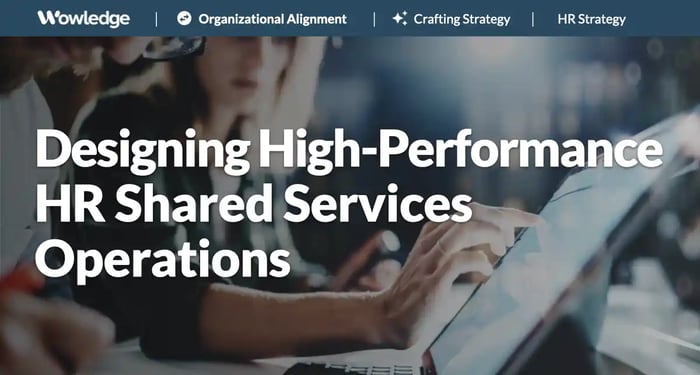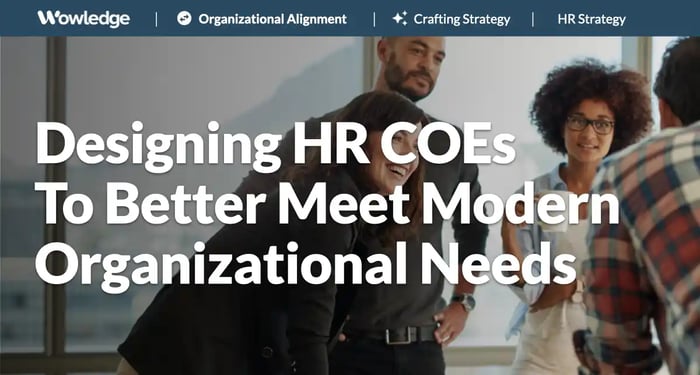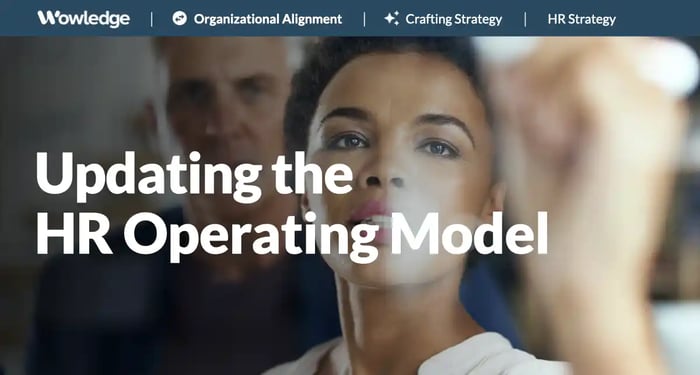Table of Contents
- The purpose and benefits of HR Shared Services operations
- The prevalence and staffing of an HR Shared Services model
- The key HR functions that are handled centrally
- Common challenges facing HR Shared Services
- Key differentiators in “good vs. great” HR Shared Services operations
- Critical considerations in high-performance HR Shared Services operations
- Relevant Practices & Tools
- About Wowledge
The efforts of human resources leaders and teams to make strategic contributions to business objectives and results are evident in the evolution of the HR Operating Model, where a continued focus on easing administrative burdens on employees, managers, and the HR team itself prevails. At the same time, recent Gartner research has found that 75% of HR leaders report that their managers are overwhelmed by increased duties and responsibilities while their budgets and headcounts are limited. The answer to this conundrum lies in establishing robust and updated HR Shared Services operations that centralize ownership of administrative and repetitive HR processes and activities, resulting in a highly efficient organization.
The purpose and benefits of HR Shared Services operations
Dave Ulrich first promoted HR Shared Services (HRSS) in his classic book, Human Resource Champions, which was designed to take responsibility for the administrative load of field HR teams, freeing them up to develop and deliver strategic programs and support for their business leaders and employees. It was created to handle everyday administrative and transactional activities and inquiries in bulk form, utilizing dedicated administrative specialists and self-service technologies that incorporate deep process and policy expertise. HR Shared Services operations are designed to administer HR systems and policies, while handling questions and issues related to these policies and processes, primarily involving transactional HR activities (e.g., payroll, benefits, transfers, new hires, pay raises, etc.). Its primary benefits include:
- Reduced duplication of staffing, work efforts, and differences in process execution and administrative policy interpretation.
- Standardization of employee service and support across business units, work locations, and functions for consistent, fair, and equitable decision-making and legal and regulatory compliance.
- Use of technology and process redesign to generate efficiencies and manage costs associated with highly repetitive, high-volume activities that engage most employees.
- Handling of common employee issues and challenges by experts trained and experienced in managing and resolving those rapidly and effectively.
- Liberating HR resources who are in a position to make strategic business contributions.
The prevalence and staffing of an HR Shared Services model
The consolidation of administrative processes and management into a single, “shared services” function has been in place for years, led by the Finance function, with 90% of surveyed companies relying on such a centralized capability. According to Deloitte’s 2025 Global Business Services (GBS) Survey, HR is the second (#2) most prominent function having such a structure, with over 60% of surveyed companies having one (IT is third, with well over 50%).
Interestingly, 48% of all enterprise HR employees (FTE) deliver these centralized services from an HRSS. However, about one-third of those are outsourced workers, indicating a trend for using outside vendors with specialized expertise to manage processes and deliver services to employees. Considering the expertise needed to stay up to date, execute and report on compliance with federal, state, and local laws and regulations (inside and outside of the U.S) in payroll, benefits, retirement and savings plans, employment laws, data privacy and security requirements, outsourcing makes a great deal of sense to many employers.
Cornell’s ILR School found that 15% of the companies it surveyed have fully outsourced HRSS and 21% have theirs included in a global business services (GBS) model, where HR shares resources and management of its transaction processing, technology management, employee and manager support, analytics and reporting, and related activities with those of other corporate functions.
The decision to outsource (fully or partially) depends on the budget, the size of the HR staff, and their capabilities. Many providers offer not only the required expertise and employee support, but also access to more advanced technologies that support efficient processes.

The key HR functions that are handled centrally
An HR Shared Services operation is primarily focused on handling the most repetitive and highest volume actions at the lowest possible cost that occur across organizational lines and levels. This typically begins with core functions that involve collecting and recording critical employee information, paying workers, supporting available welfare and retirement benefit plans, handling questions and resolving issues, providing support for medical, family, and leave matters, and managing hiring and termination processes. The common-use HR systems, employee communications, and policy execution and administration are also handled here, and include:
- Employee data management: Maintaining accurate and confidential employee records, ensuring compliance with data protection regulations.
- Payroll processing: Managing employee salaries, bonuses, tax and benefit deductions, and ensuring timely and accurate compensation.
- Benefits administration: Handling enrollment, changes, inquiries, and execution of employee benefits programs, including health and welfare, retirement and savings, insurance, employee assistance (EAP), relocations, rewards and recognition, paid time off (PTO), educational reimbursement, and special perquisites (“perks”) such as employee discounts, memberships, wellness, and onsite amenities.
- Employee onboarding and offboarding: Managing the administrative aspects of bringing new employees on board and offboarding departing employees.
- HR technology management: Managing and maintaining all HR information and talent management (HRIS/HCMS/TMS), learning management and experience (LMS, LCMS, LXP), applicant tracking and relationship management (ATS, CRM), employee listening and experience, and related systems.
- Employee inquiries: Providing help desk support that addresses employee and manager queries related to HR policies, procedures, benefits, systems, and relevant labor laws and regulations.
- Reporting and analytics: Providing insights, reports, and dashboards on HR metrics to support analysis and decision-making, including responses to other employer inquiries for reference checks.
- Legal and regulatory compliance: Generation of data and responses to governmental inquiries related to unemployment, health and safety, leaves, and legal and regulatory complaints and filings.
More mature organizations are increasingly establishing strategically essential capabilities that are needed and utilized in HR initiatives related to the HRSS mission. The shared services team collaborates with HRBPs or COEs to define requirements, design interventions, and leverage technologies and apps to execute those plans. Companies are leveraging the HRSS as a best practice “home” for some of these that can be used either by HRSS or in support of strategic business efforts of COEs or HRBPs, such as:
- Process management and redesign
- Change management
- Project management
- HR systems selection, configuration, and implementation
Other capabilities are finding their way into HR Shared Services operations as a means of improving the consistency and efficiencies involved in processes and activities that have traditionally been left to individual HRBPs, HR Managers, or Generalists. In these cases, the HRSS team follows the lead of the HRBP or COE, who are responsible for designing and developing the strategy and standards against which the HRSS team will execute. Examples include:
- Employee relations (e.g., Level 1 and Level 2 issue inquiry support and resolution)
- Employee listening (e.g., survey administration, compilation, analysis, presentation)
- Recruitment processing (e.g., job postings, screening, candidate contact and updates, reference checks)
- Learning and development (e.g., managing course catalogs, registrations, logistics, measurement, and reporting)
- Compensation administration (e.g., annual merit increase process and processing, salary scale and classification updates, mid-year review process, pay equity analysis)
- Performance Management (e.g., update systems and forms, employee and manager workflows, provide status reporting and updates, and track for compliance with policies, standards, and procedures)
According to Deloitte’s recent survey, across all corporate functions the top capabilities that have been implemented by all functions combined include process excellence and continuous improvement (75%) reporting and analytics (73%), change management and training (59%), risk & compliance (57%), and talent management (55%).
For HR Shared Services operations in particular, it found that 79% of surveyed companies use it for payroll, 57% for HR Analytics and Reporting, and 57% for Recruitment and Staffing Administration. Estimates are that between 50% and 60% of HR organizations outsource some of their processes.
Common challenges facing HR Shared Services
Given the very nature of a centralized HR capability, it is no surprise that companies of all sizes and scales face similar issues in providing consistent support across the full range of business units, corporate functions, and employee types. Consider the varying needs, requirements, and preferences of leaders, managers, and employees in different types and locations of operations (such as manufacturing vs. research and development, sales vs. finance, large city vs. small town, U.S. vs. Asia). The value proposition of any shared services operation is delivery at volume, which is often at odds with leaders’ and managers’ desire for tailored solutions. That said, everyday issues that require attention and management include the following:
Technology integration
Centralized HRIS teams are commonplace and regularly report issues with properly linking many HR and related systems. Such problems start with a lack of a clear and well-defined data dictionary and input forms that reliably support user data accuracy and validation. Problems with shared data storage and cross-system updating inhibit the accuracy and capability to auto-populate forms and inputs across HR platforms and integrated processes. To best meet their promise, the advanced technologies that enable efficient and timely self-service, such as chat, mobile, chatbots, robotic process automation (RPA), and AI-based recommendations and guidance, all require access to multiple systems and shared data fields.
Change management
Every change that an HR Shared Services operation implements, by its very nature, impacts employees across a spectrum of job roles, education levels, technological savvy, and personal expectations and preferences. As a result, formal change management strategies must regularly account for a wide range of expectations and readiness for change, making this capability an essential element of every process improvement, system upgrade, technology adoption, and policy change. The skills and patience to plan and execute these are often given less attention and resourcing.
Overly standardized processes and practices
A frequent critique of shared services operations (in HR and other functions) is that they overemphasize efficiencies and cost savings at the expense of quality, well-informed support, or strategically critical or unique organizational requirements. While personalization is a preferable approach wherever possible, consistency of application is also a worthwhile goal in the name of equitable and fair treatment of employees. Balancing those two competing agendas often leans towards a strict interpretation and a lack of flexibility, which strains both manager and employee satisfaction with HR Shared Services operations.
Impersonal, under-responsive support
The desire for a “human” voice, reasoning, and judgment is a common complaint heard from many retail customers, who complain about trying to resolve issues with a “faceless” customer support representative who does not understand their “unique” circumstances. Even worse is a computer-driven voice response unit (VRU) that is increasingly AI-generated and informed. Further challenges with chatbots, including their design and programming, will persist despite a surge in popularity, driven by cost management and staffing challenges, and continue to represent a risk to be overcome by organizations.
Staffing
Hiring and managing employees in an HR Shared Services operation presents a challenge, as these roles tend to be staffed with practitioners who are more specialized and earlier in their careers. They become experts in administrative excellence, process tracking, improvement, efficiency, policy interpretation, and compliance in very narrow areas. That specialization can often lead to team members with restricted skill sets and higher turnover unless career development and job rotation are implemented. In addition, Deloitte reports that 41% of organizations struggle to recruit talent with the right skills, and 34% with retaining such talent. The rapid emergence of artificial intelligence and chatbots has also raised concerns about the near-term viability and attractiveness of those roles.
Managing outsourced vendor service delivery and quality
Outsourcing of HR Shared Services operations is expected to grow as companies seek to access new technologies, deep expertise, and improved cost savings that those vendors offer. Managing large vendor contracts is a capability that employee benefits, compensation, HRIS, and, to a lesser extent, recruiting teams possess; however, these are small teams with fewer experts. The capability of developing operationally sound requirements, performance standards, and measurement strategies, as well as overseeing contract negotiations and managing multiple vendors to these standards, is a significant challenge for many HR leaders.

Key differentiators in “good vs. great” HR Shared Services operations
What separates an HRSS function that “meets” expectations versus one that “consistently exceeds” expectations? The answer lies primarily in the minds of an organization’s employees. Reaching that answer requires asking the end-users of the services and capabilities the right questions and then acting on their responses. That said, there are clear lessons learned from implementing and managing HRSS operations that separate the best from the rest.
Customer-focused culture
A commitment across the HRSS team that informs and directs how they design processes and systems, deliver support, get the correct answer quickly and efficiently, and follow up to confirm employee success. This is achieved by utilizing human-centered design approaches, hiring for emotional intelligence and communication skills, and continually developing the team’s expertise in their assigned and related areas of focus.
Ease of access and support
Incorporating technology user interface concepts such as single sign-on (SSO), intuitive search, and well-tagged resources, policies, documents, processes, and procedural guides. Establishing fast and efficient methods for locating the proper expert when self-service fails to resolve an issue, question, or concern. Consider adopting an AI chatbot that can quickly identify a manager’s or employee’s core question or problem and then direct the individual to the right level of expert for that issue.
Technology that “knows” and remembers the employee
The integration and synchronization of all employee data across various (HR and business) systems and apps that auto-populate known data, and use the individual’s current organization, function, role, and level to determine related permissions and system, resource, and facility accesses. Easily accessed information on requests, choices, and approvals of benefits, development, and leaves. The availability of AI-supported reminders, recommendations, and action plans, based upon current responsibilities and goals, development needs, and aspirations.
A note on AI use in HR Shared Services operations
Despite the press coverage and hype surrounding the rapid adoption of advanced technologies (RPA, Machine Learning, AI, and GenAI), research suggests more promise than delivery. This is due to a current shortage of internal expertise, mixed with capability issues related to data quality, cybersecurity, and data governance. Cross-functional GBS (Global Business Services) organizations have achieved a financial ROI of less than 10% in benefits from GenAI to date.
That said, 30% of GBS teams are currently implementing GenAI in HR Shared Services, with another 36% planning to do so. Many leading HR information and Talent Management systems vendors have, or are adding, AI-driven capabilities to their platforms.
Critical considerations in high-performance HR Shared Services operations
When designing, upgrading, or evolving an HRSS, certain elements and capabilities differentiate impactful organizations from those focused purely on process centralization for the sake of cost savings and efficiency.
1. Engage leadership with robust governance
Create a structured approach to build buy-in and active support by establishing a shared services operations leadership council, which reviews strategies, improvement plans, budgets, and ongoing, measurable performance. Install a singular head of all HRSS functions, regardless of whether the centers are deployed regionally, in a single central location, offshored, outsourced (hybrid model), or combined with those of other functions.
2. Create a culture of customer service excellence
Develop a team that focuses on the needs of employees and managers, and how to make their work lives and administrative activities easier. Use employee listening approaches and user experience analytics to keep a “thumb on the pulse” of the employee experience with processes and systems. Take action on feedback and user preferences with an eye on continuous improvement and promote or communicate user-focused enhancements. Engage and reward HRSS team members in delivering speedy, responsive, and quality support to employees and managers. Hire, develop, and manage team members to adopt this as their mission and mantra.
3. Evaluate the employee experience (EX) and the employee journey
Engage employees, managers, and leaders in identifying the most crucial “satisfiers” and “dissatisfiers” that drive their perceptions of service access and quality. Identify those “moments that matter” (MTMs), which reveal process and practice shortcomings, and then design improvements to deliver services best across the primary activities they encounter in the employee lifecycle.
4. Clarify HRSS roles and responsibilities in the HR operating model
Conduct a formal assessment and planning effort around the HR operating model to define the roles and responsibilities of HRSS relative to their peers in the COE and HRBP teams. Create clarity about what each team does, does not do, and how their efforts will be integrated and handed off on a process-by-process basis. Choose wisely which processes will and will not be included to determine where centralized, localized, or specialized HR support makes the most sense. Not every repeated transaction or decision is suited for centralization.
5. Leverage HR technologies intelligently
Implementing and configuring systems requires careful planning and an understanding of their purpose, value proposition, and use cases. HR process and functional experts should regularly review the effectiveness and opportunities for enhancing usability and utility. Focus on end-user ease of use by streamlining process steps, ensuring input reliability and accuracy through the integration of data across systems and modules, and enhancing productivity through the use of advanced automation and technology-enhanced entry and processing.
6. Develop expertise in change management and process improvement
Leveraging strategic change management and process improvement (e.g., Lean, Agile, Six Sigma) requires a certain level of training and expertise that can be disseminated across the entire HRSS team to support a culture of efficiency and effectiveness. These capabilities also help employee and manager adoption and acceptance rates (and speed) as enhancements are introduced. Given the blend of human and technology-enabled support offered by the HR Shared Services operations, these together help address its key value proposition.
7. Measure and track delivered support and outcomes
Establish performance standards for HR Shared Services operations, and create service-level agreements (SLAs) that serve as goals. Utilize multiple data sources to develop a comprehensive evaluation capability, including trouble tickets, (brief) post-support employee and manager satisfaction surveys, and design thinking feedback and innovation sessions. Rely upon classic IT success measures, such as uptime, first call resolution rate, unresolved ticket backlog, network latency, security incidents, and user adoption rates to complete the picture.
Relevant Practices & Tools
Advanced HR Strategy Practices to Plan for Delivery of Impactful HR Services and Support. >
Advanced HR Strategy is a refined approach to planning long-term HR priorities. It involves increased specificity of plans and goals around key employee groupings and uses detailed workforce data and projections to clarify the needs and trends impacting those groups... more »
Core Change Management Practices to Engage Stakeholders and Drive Sustained Adoption. >
Change Management is a set of activities to help people understand why changes are being implemented, communicate how different people or groups will be impacted, and prepare them to be successful... more »
Identifying Critical Audiences and Tailoring Metrics and Reporting to their Unique Needs. >
Critical audiences typically include management from different levels and functions. Interviewing them to receive guidance on their key questions is invaluable to tailoring metrics and reporting... more »
Preparing the Organization for Digital Transformation to Manage the Change. >
Any transformation benefits from a guiding hand that helps navigate the journey’s challenges. HR can significantly guide the organization and shape the experience, culture, and support for the effort... more »
The Stakeholder Analysis Template: Identify the Individuals Needed for Successful Change and Their Level of Support. >
This template and process help organizations discover what stakeholders need and expect from a change initiative... more »
About Wowledge
Wowledge is the implementation-first platform designed for lean HR teams and consultants who need to design and scale strategic HR programs efficiently—without starting from scratch.
Our members gain access to continuously updated best practices, step-by-step guidance, expert-built tools, and customizable templates—all structured to accelerate the development and implementation of key HR programs.
Recognizing that every organization operates at different levels of sophistication, Wowledge’s scalable system of best practices follows a stage-based approach—Core, Advanced, and Emerging—ensuring HR professionals can implement solutions tailored to their organization’s unique needs and goals.
Your Shortcut to Amplifying HR Impact!
Get started for FREE! Learn more.










